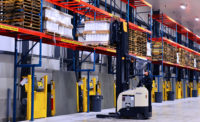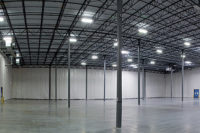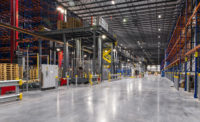New plant design can be quite a bear. Site selection, layout, structural systems, construction materials, timelines and more all play into successfully building a cold storage facility. Refrigerated & Frozen Foods interviewed several architectural, engineering, construction and design-build firms to find out how increased regulatory changes impact the way facilities are designed, how Greenfield construction is LEEDing the way and what today’s cold storage construction industry can do to prepare for tomorrow’s natural disasters.
How increased regulatory changes impact design
Increased regulatory changes in food safety and security continue to keep the cold food industry on its toes. Whether it’s a new law, revised law or merely a suggestion, such changes can pose a great impact on the way facilities are designed, constructed and/or revamped.
For instance, increased security concerns are primarily driving the external design of distribution facilities, says Michael Smith, director of project development for Stellar, Jacksonville, Fla.
“Almost all facilities are now completely fenced and access is controlled through a gate or guardhouse to properly screen all visitors,” Smith adds. “We’re also making modifications in truck arrival and loading areas, as facilities are also stepping up their inspection of trucks to ensure there is no possibility of tampering or contamination. In addition to food safety, almost all cold storage facilities have ammonia on the premises that must be properly secured, which is driving some redesign issues.”
At A M King, Charlotte, N.C., food safety is taken into account in every aspect of their design and construction.
“The elimination of ledges and crevices, providing greater ability to properly clean work spaces and the use of physical barriers to separate raw product employees from ready-to-eat product employees are all examples of an increased focus on food safety,” says Stuart Jernigan, director of pre-construction. “From a security standpoint, data recording—not just data monitoring—is now becoming the norm with regards to items such as room temperature, air pressures, humidity levels, etc.”
Because SQF- and BRC-certified facilities require higher standards, Tippmann Group, Fort Wayne, Ind., takes clients on tours of its SQF-certified warehouses during the design phase “to discuss how we can enhance food safety in the new building,” says Steve Tippmann, executive vice president.
Bigger is not always better
For many companies, it’s more about building up, not out. That’s because small and compact operations tend to offer bigger than big results.
“In Joliet, Ill., we recently opened one of the tallest (50-foot top of product) manual cold storage warehouses in the country,” says Tippmann. “Our operators utilize cameras mounted on the mast of the forklifts to guide the pallet in and out of the locations. For the most part, construction cost, utility cost and even to some degree, real estate taxes are driven by square feet, not cubic feet, so a new taller warehouse can cost less and operate for less per pallet position.”
For ESI Group USA, building up has always been an intriguing option where land availability is a premium or limited. Modular process systems that are pre-fabricated, piped or mounted on skids provide flexibility, reduced on-site installation and the capability to configure and set on mezzanines and platforms.
“Increasing cube space by building higher provides certain benefits such as increased number of pallet and pallet positions per cubic volume,” says Timothy Nguyen, regional vice president for the Hartland, Wis.-based design-build firm. “However, the downside is increased costs for material handling equipment such as automated cranes, elevators, conveyors, carts and sophisticated software.”
Stellar’s customers also request to build taller buildings where land is at a premium, says Smith, but there are several considerations to keep in mind before making a decision.
“Current fire protection technology limits storage height to 40 feet without the use of in-rack fire protection systems,” he adds. “Also, storing much higher than 40 feet requires different lift equipment. It’s also important to consider the height limitations of the facility’s existing forklifts and whether to build a high-rise storage facility is flexible for future use. A short-term contract for high-rise storage space may leave a customer with unused storage volume if future contracts can only support a traditional 40-foot storage requirement.”
Meanwhile, A M King looks beyond the typical design and build mentality.
“We work to understand [our customers’] process flow, freezing or cooling needs, storage requirements, transportation operation and the expectations of their customers,” says Jernigan. “This provides us with the ability to develop a number of solutions for our clients, so that they can understand the initial costs, the lifecycle costs and return on investment of building large or small or building up or out.”
Greenfield construction LEEDs the way
There’s no questioning it—Greenfield construction is on the rise. Factors such as sustainability, ergonomics, regulatory demands and customer’s innovative wants and needs pose promising challenges for the design-build industry.
Case in point—incorporating sustainable initiatives in the design phase provides a return on investment and just makes economic sense, says Jernigan.
“This includes items such as variable frequency drives, daylight harvesting, LED lighting and solar panels for hot water pre-heat,” he adds. “Ergonomic initiatives to improve worker productivity may include natural light in applicable areas, reduced lifting by utilizing better production line designs, elimination of sharp objects that can easily cut or scratch and measures to provide noise reduction in the processing areas.”
Additionally, tighter storm water management requirements force end users to build from scratch, so to speak.
“We have seen up to 35% of the land purchased be consumed with the newer storm water management requirements in some locations,” says Tippmann.
LEED certification also plays a large role in designing new Greenfield construction.
“There is a growing emphasis on sustainability, renewable energy and environmental integrity in building new facilities,” says Nguyen. “Therefore, actual certification is important and provides an economic incentive to achieve certain levels of LEED certification.”
However, attaining such credits involve energy efficiency measures, which for the most part are already incorporated in modern food facilities regardless of pursuing LEED certification, he adds.
“Therefore, if companies are already incorporating energy efficient designs because of long-term benefits, the additional measures to ensure LEED certification now becomes potentially more plausible,” Nguyen says.
Other cold storage construction trends involve reduced footprints, higher construction elevations and automated operations, says Erik Gunderson, executive vice president of Primus Builders, Inc., Woodstock, Ga.
“End users are focusing more than ever on energy cost,” he adds. “The features to provide more efficiency are looked at harder in today’s market despite higher capital expenditures. Energy is a top cost, and finding ways to reduce use is paramount in today’s cold storage construction.”
When Mother Nature strikes
When Mother Nature strikes, bringing with her flooding, high winds, fluctuating temperatures and more, today’s design-build firms are taxed with planning for the worst-case scenario. However, planning for natural disasters can be extremely cost prohibitive, says Nguyen.
“There is a limiting factor on how facilities can be designed to withstand insurmountable forces unleashed by weather and the environment,” he says. “However, certain design parameters have already been in place for structural systems to withstand high snow loads, roof design and external doors/window openings for extreme wind speeds in hurricane zones and refrigeration design in high-temperature environments.”
For example, companies can install full-reserve electrical backup with an emergency generator, so facilities can still operate even with the complete loss of electricity.
Stellar often incorporates equipment into its electrical design to allow for either partial or complete backup of plant power systems.
“It’s also important to build in mechanical system redundancy and account for ammonia storage issues,” says P. Wyatt Payne, Jr., vice president for Stellar. “As a result of significant storms in the Northeast the past few years, we’ve worked with clients to raise their existing electrical infrastructure, build raised platforms for generators and other critical equipment above flood stage to ensure their facilities will function during and after storm events.”
Effective site management and construction sequencing can also help mitigate Mother Nature’s effects, according to Gunderson.
“We try to get the under-floor warming in and cover up with sub slab prior to erecting the frame. In terms of nature-resistant facilities, our engineering group works closely with the roofing and wall panel manufactures on attachments,” he adds. “Finally, we offer PERT—the Primus Emergency Response Team. When our customers experience building envelope failure, our team is at the ready to close up the building and secure it, so operations can continue.”
Although not necessarily new technology, the folks at A M King are seeing an increasing number of requests for dual-purpose safe rooms.
“For instance, a break room may now be designed to also function as a tornado or storm shelter in the case of an emergency,” says Jernigan. “We have also seen an increase in the installation of exterior walkway glycol systems and radiant heat in many northern locations.”
In colder climates, other design criteria include docks facing south, so the sun melts snow and ice.
“To say the least, it is tough and expensive to push through the extreme cold temperatures we experienced,” says Tippmann. “In the colder climates, it is ideal to have the buildings enclosed prior to December.”
Whatever the challenge or customer request, today’s design-build firms are in position to build safe and sustainable cold storage facilities that meet tomorrow’s ever-changing wants and demands.







